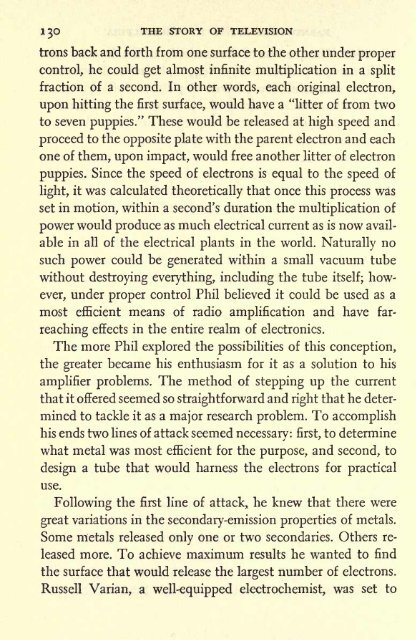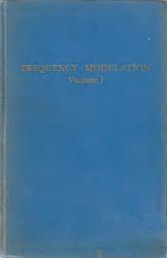the life of Philo T Farnsworth - Early Television Foundation
the life of Philo T Farnsworth - Early Television Foundation
the life of Philo T Farnsworth - Early Television Foundation
Create successful ePaper yourself
Turn your PDF publications into a flip-book with our unique Google optimized e-Paper software.
130 THE STORY OF TELEVISION<br />
irons back and forth from one surface to <strong>the</strong> o<strong>the</strong>r under proper<br />
control, he could get almost infinite multiplication in a split<br />
fraction <strong>of</strong> a second. In o<strong>the</strong>r words, each original electron,<br />
upon hitting <strong>the</strong> first surface, would have a "litter <strong>of</strong> from two<br />
to seven puppies/' These would be released at high speed and<br />
proceed to <strong>the</strong> opposite plate with <strong>the</strong> parent electron and each<br />
one <strong>of</strong> <strong>the</strong>m, upon impact, would free ano<strong>the</strong>r litter <strong>of</strong> electron<br />
puppies. Since <strong>the</strong> speed <strong>of</strong> electrons is<br />
equal to <strong>the</strong> speed <strong>of</strong><br />
light, it was calculated <strong>the</strong>oretically that once this process was<br />
set in motion, within a second's duration <strong>the</strong> multiplication <strong>of</strong><br />
power would produce as much electrical current as is now available<br />
in all <strong>of</strong> <strong>the</strong> electrical plants<br />
in <strong>the</strong> world. Naturally no<br />
such power could be generated within a small vacuum tube<br />
without destroying everything, including <strong>the</strong> tube itself; however,<br />
under proper control Phil believed it could be used as a<br />
most efficient means <strong>of</strong> radio amplification and have farreaching<br />
effects in <strong>the</strong> entire realm <strong>of</strong> electronics.<br />
The more Phil explored <strong>the</strong> possibilities <strong>of</strong> this conception,<br />
<strong>the</strong> greater became his enthusiasm for it<br />
as a solution to his<br />
amplifier problems. The method <strong>of</strong> stepping up <strong>the</strong> current<br />
that it <strong>of</strong>fered seemed so straightforward and right that he determined<br />
to tackle it as a major research problem. To accomplish<br />
his ends two lines <strong>of</strong> attack seemed necessary: first, to determine<br />
what metal was most efficient for <strong>the</strong> purpose, and second, to<br />
design<br />
use.<br />
a tube that would harness <strong>the</strong> electrons for<br />
practical<br />
Following <strong>the</strong> first line <strong>of</strong> attack, he knew that <strong>the</strong>re were<br />
great variations in <strong>the</strong> secondary-emission properties <strong>of</strong> metals.<br />
Some metals released only one or two secondaries. O<strong>the</strong>rs released<br />
more. To achieve maximum results he wanted to find<br />
<strong>the</strong> surface that would release <strong>the</strong> largest<br />
number <strong>of</strong> electrons.<br />
Russell Varian, a well-equipped electrochemist, was set to











